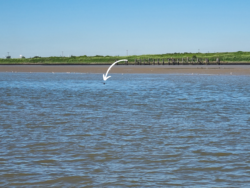It often surprises people to learn of the biodiversity that is present in the Thames Estuary. This includes two species of seal, grey seals (Halichoerus grypus) and harbour seals (Phoca vitulina). Seal populations in the Thames have been monitored since the early 2000s and recent population surveys estimate a total of 790 harbour and 2,860 grey seals living within the Greater Thames Estuary (Zoological Society of London).
These two species have some clear differences in appearance and behaviour which allow them to be identified. Firstly, adult grey seals can weigh up to 300kg which makes them much larger than harbour seals that usually weigh between 80 and 100kg. Grey seals also have flatter head profiles and a longer snout, with nostrils that are parallel and do not meet. Whereas harbour seals have round heads and ‘v-shaped’ nostrils that meet underneath. Another visible difference is fur colour. Harbour seals have lighter grey/brown colouring and grey seals have darker grey/brown fur with mottled patterns. However, in the Thames seals have been seen to appear bright orange as their fur has been stained by iron oxide in the water and the muddy banks they lie on.
In terms of behaviour, it can be observed that Harbour seals tend to haul out further apart from each other and avoid touching whereas grey seals sit near each other and will sometimes gather in large groups. In the summer months it is likely that seals will be seen hauled out more frequently around the UK coast. During which, they may be resting, breeding, nursing, and/or undergoing their annual moult.
Although grey seals are of ‘Least concern’ on the IUCN Red List of threatened species, their protection and conservation remain important. In the early 20th century UK grey seals were hunted which led to a decline in population size to fewer than 1000 individuals. Today, the UK’s population of grey seals is estimated at 120,000 individuals. The protection of seals under UK legislation since 1970 has greatly supported the recovery of grey seals and is necessary to keep this healthy population going. Seals are protected by various UK legislations which prohibit the injuring, killing, or capturing of seals under any circumstances. As is specified in The Conservation of Seals Act 1970, it is an offence to recklessly injure or kill a seal. This act was updated to remove the ‘netsman defence’ in 2021 which had previously provided a defence against prosecution if a seal was killed to protect a fishing nets or tackle. Furthermore, seal species present in the UK are listed in Annex 2 of the EU Habitats Directive and 16 Special Areas of Conservation (SACs) have been designated specifically for seals in the UK.
Whilst wild seals are amazing to observe it is important to keep yourself and the animals safe whilst doing so. Always keep distance of at least 50m from a hauled-out seal, especially from pups, to avoid intimidating them which may cause them to enter the water. It is normal for seal pups to spend long periods of time on land when they are too young to swim properly or catch their own food so forcing them into the water can be harmful. This is especially true for grey seals which spend up to six weeks on land after they are born and only enter the water once they have moulted their baby fur. Seal pups rely on their mothers greatly and should not be separated. Sadly, mothers may reject pups if they smell of humans which is why keeping a distance and never touching seals is vital.
If you do however come across an injured seal this summer, please call the British Divers Marine Life Rescue on 01825 765546. This will enable trained individuals to handle the situation and ensure the proper care of the animal.
The Zoological Society of London (ZSL) has been collecting information on seal sighting within the Thames Estuary to better understand their activity and conserve them in the area since 2004. The ZSL invite the public to report any sightings of seals in the Thames via their website. For more information on how to report a seal sighting, you can access the ZSL code of conduct here.


